Blog and photos by Marcus Weiner
How to make burger and breakfast sausage were questions on my mind when I first started hunting. I hunt for food, and my boys love breakfast sausage, chili, tacos, meatballs, and goulash. So figuring out what to do with the game animals I bring home started with determining how I like to cook them.
After all the hard work in the field, hunters across the Great Land are faced with decisions on how to process and break down their hard-won game. Over the years I have learned what my family likes to eat and I break my game down with that in mind. In a nutshell, I want about 25% of the animal turned into burger, 25% into breakfast sausage and 50% as steaks / roasts.
To begin, I’ll break the rear quarters down into sirloin, top round, bottom round, eye of round and shank. There’s very little left on the bone when you break the rear quarter into these sections, but what is left goes into the burger pile. I take all the meat from the front shoulder, neck, rib meat, brisket, skirt and flank and add that to the burger pile. Tenderloins are typically eaten fresh, and backstraps are reserved for steaks or medallions.
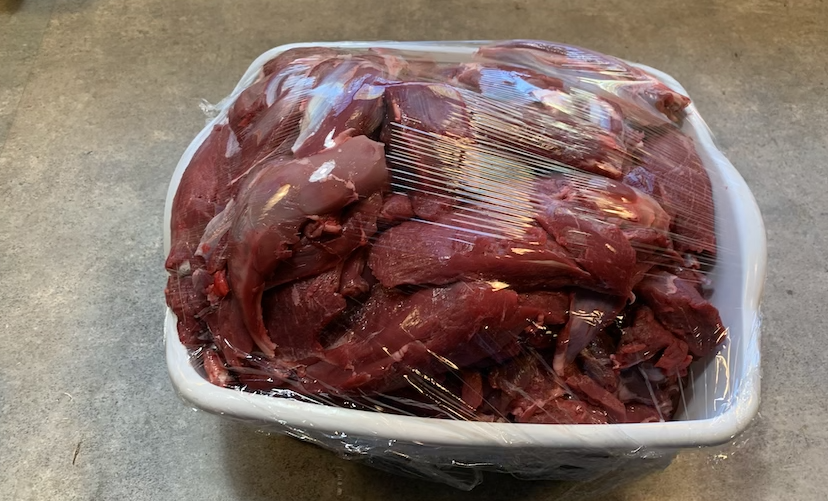
30 pounds of deer set aside for grinding.
To make burger, I’ll grind a ratio of 80% wild game (remove all the fat, and as much sinew and silver skin as possible) to 20% pork shoulder. I used to use suet (cow fat), but it can be hard to find and I’ve found that the burger tastes better with the addition of some pork muscle and fat. Plus it’s easy to find. Some may add more or less filler to make burger and sausage, I find 20% sufficient to provide some flavor and fat, but preserve the wild game flavor, so this blog on how to make burger and breakfast sausage can be tweaked to fit your tastes.
Cut the meat into chunks that are small enough to fit into your grinder. I use a Weston or LEM commercial grinder, which grinds meat very quickly and efficiently. The Weston 750 Pro #22 grinds 14 pounds of meat per minute, so you can output a lot of burger in little time. Start with your pork in one bin and game meat in another. You’ll need something to catch the burger, and I use a Weston 40 lb Heavy-Duty Meat Lug to capture the ground meat.
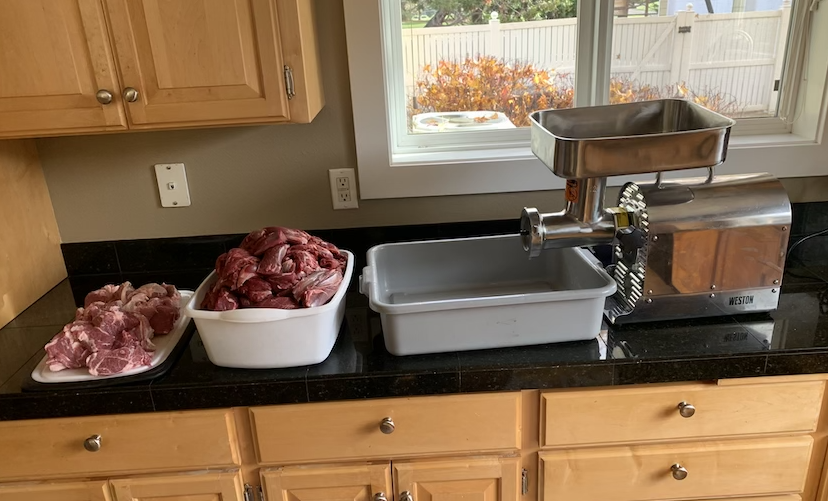
Deer, pork, grinder and meat lug ready for use.
Turn on the grinder and begin to grind. Try and add about four parts wild game to one part pork as you go to get an even mixture. Some people will grind a second time to further promote proper mixture, but I don’t feel that’s necessary. I turn roughly 50% of the animal into burger at the outset, since my breakfast sausage simply requires adding seasoning and water to the ground meat mixture.
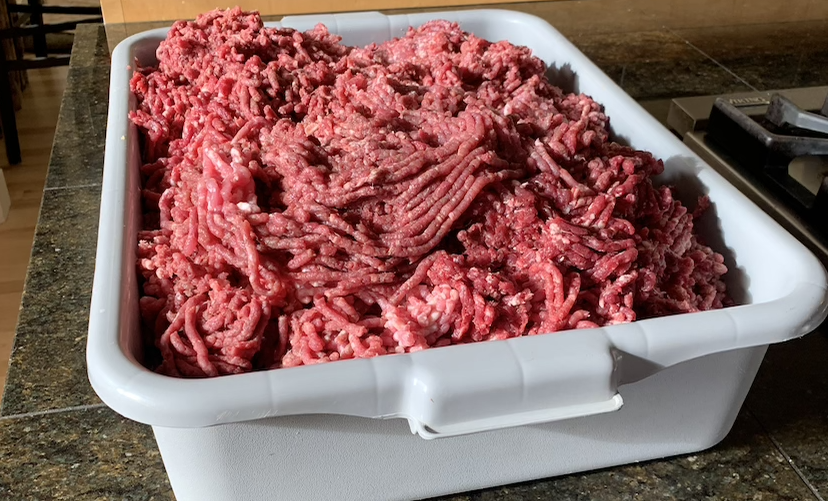
It took less than 10 minutes to grind this 36 pounds of burger.
Next thing to do is make the sausage. My family loves the LEM Backwoods Fresh Breakfast Sausage Seasoning. To make 25 pounds of breakfast sausage, combine the entire 8.3-ounce packet with 25 ounces of water, mix into a slurry, and add to 25 pounds of ground burger. Use your hands to mix the slurry into the burger, cover and put in the refrigerator for one day. After allowing it to sit for about four hours, I go back and mix again to further promote even mixing. Some people run the mix back through the grinder for even mixing, but again, I don’t feel like that’s needed and the seasonings become evenly mixed with some elbow grease. It’s critical that you leave it in the refrigerator for a day to let the seasonings combine with the meat. I choose to cook the sausage as patties, so don’t mess with casings for making links. If you prefer to put your sausage in casings, check with LEM for products needed to make breakfast sausage links.
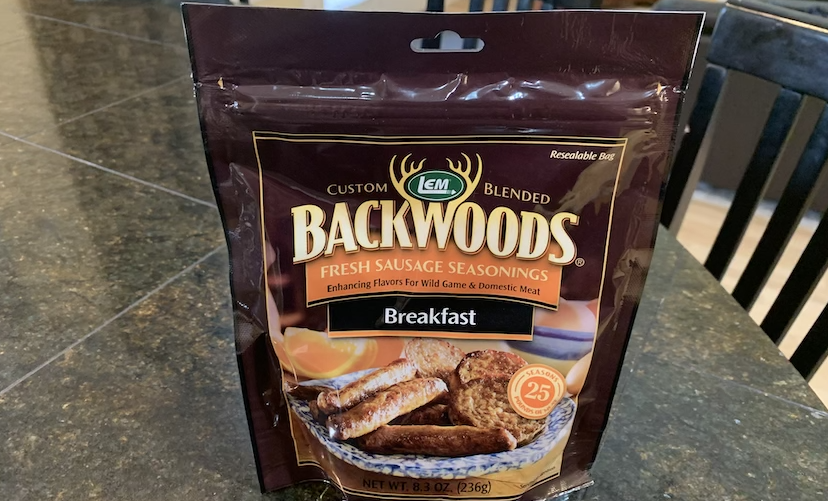
The LEM Backwoods brand of seasonings is excellent.
When storing in the freezer, especially on large animals like caribou, elk and moose, I’ll first cut the roasts and steaks into about 3-pound chunks. This gives me the freedom later to cook them whole as a roast, slice thin for jerky or stir fry, cut thick for steaks, and grind up when we run out of burger. For premium cuts like eye of round and backstrap, I’ll usually pare those down to one-pound portions so they last longer.
I begin by wrapping each large chunk of meat in two layers of commercial-grade plastic wrap. I push the air out as I am sealing the wrap on itself and try and tuck in the outer flap to further force out the air. After two layers the meat is sealed up in a solid layer of plastic and mostly devoid of air. Next step is to wrap it in butcher paper. Cut off about an 18-inch square, position it like a diamond, place the package at the bottom of the diamond, roll the package towards the top of the diamond once, then fold in the left and right flaps, rotate towards the top again to trap the sides, fold the excess at the top into a triangular shape and tape to the package with masking tape rated for use in a freezer. You’ll need a permanent marker so you can mark what cut is in the package.
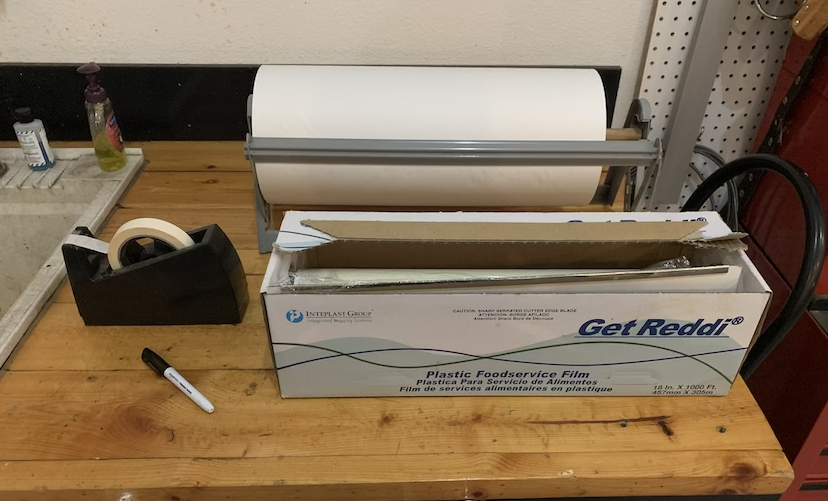
Commercial-grade plastic wrap, butcher paper on a dispenser, freezer-rated masking tape and a permanent marker are necessary tools when packaging meat for the freezer.
I do the same thing with the burger and sausage, only in smaller servings. I gather a double handful, it is larger than a baseball and a bit smaller than a softball, and averages to about 1.5 pounds. I wrap each portion first in plastic then in butcher paper. I have found that game processed this way will last for a couple years in the freezer and rarely gets freezer burned.
How to make burger and breakfast sausage first starts by breaking down the animal properly in the field. Then it requires time and effort to dissect the larger sections and reserving those designated for grinding. You’ll need to decide if you want to add pork, beef, something else, or nothing to your ground mixture; we find pork shoulder works best when making burger and sausage. After grinding, set aside the burger intended for sausage. Mix with sausage seasoning and water, and give the mixture some time to incorporate – say 24 hours – before packaging for the freezer. When wrapping meat, burger and sausage for freezing, do your best to squeeze out air as this will help preserve the protein for a long time in the freezer without freezer burn.

Packages of wild game meat ready for consumption, a happy sight for any hunter. B stands for burger, S for sausage and BS for backstrap.
So there you have it, how to make burger, breakfast sausage and package your game for storage. When it’s time to cook a great meal for your family, you’ll be able to quickly find the right cut that shines for that preparation. And if you are like my family, there’s always a package of breakfast sausage in the refrigerator.
Marcus Weiner is the Publisher and Co-Founder of Hunt Alaska and Fish Alaska magazines. Part of being a good dad is teaching his boys how to hunt for and cook the game they take.
